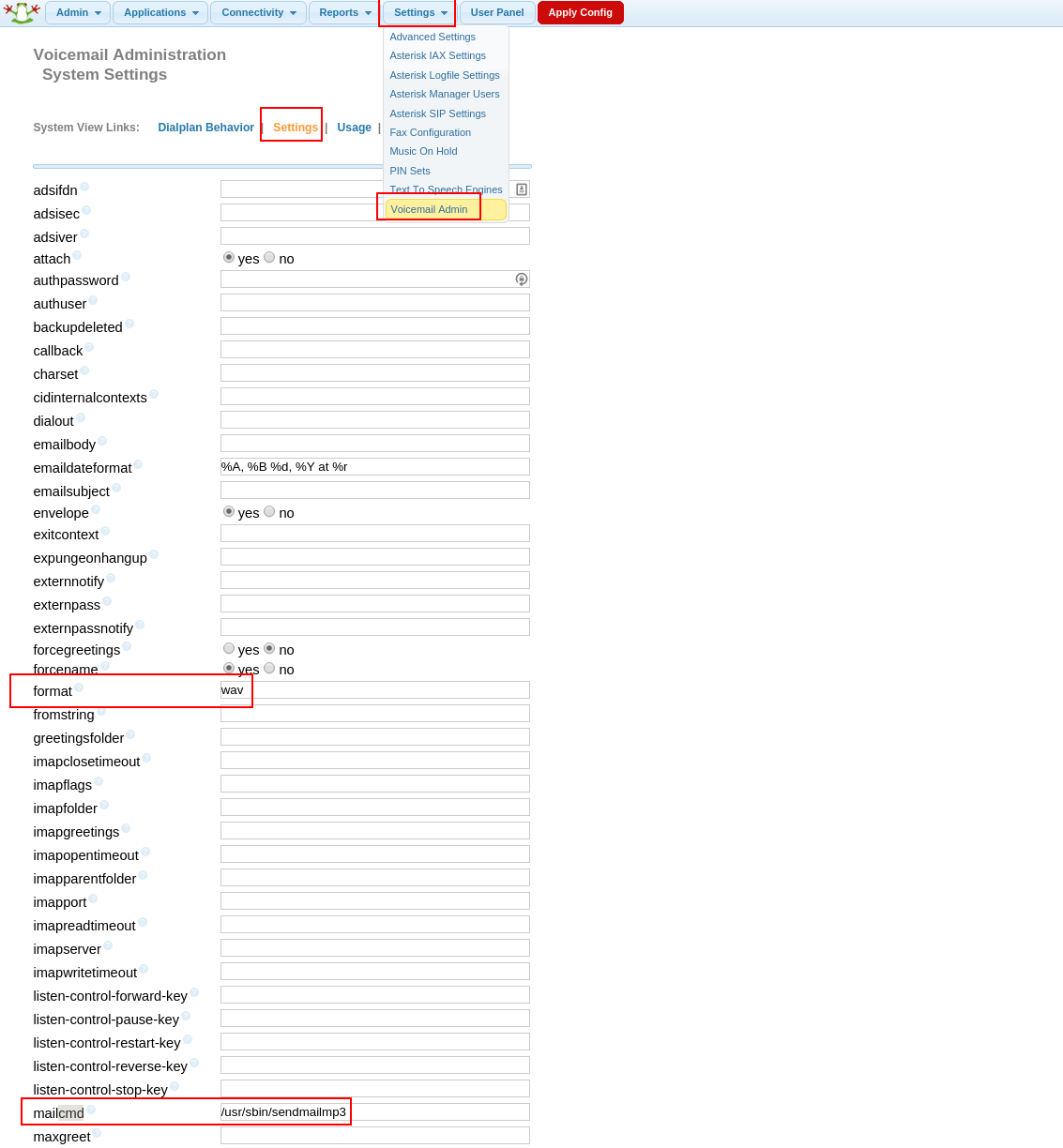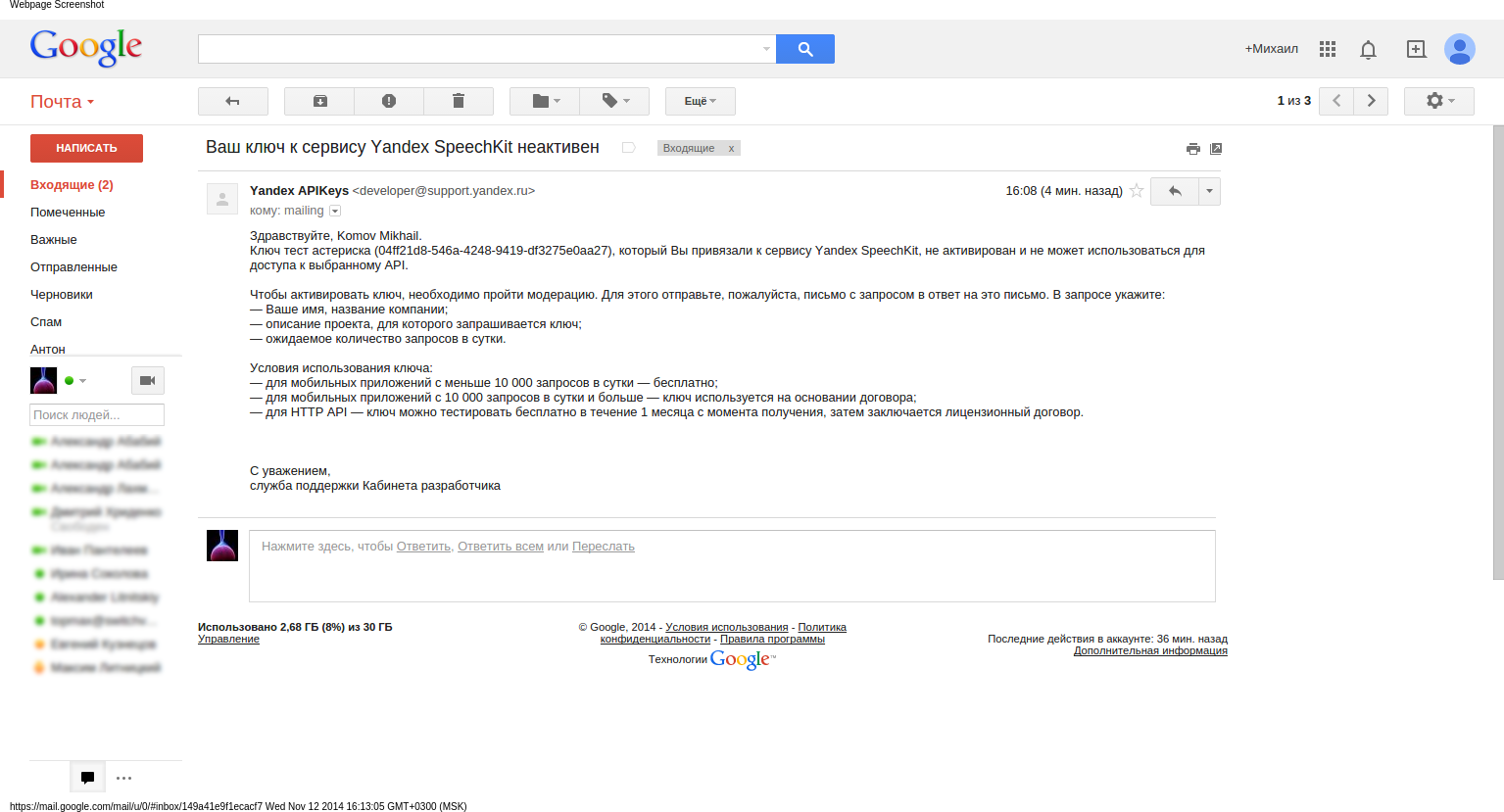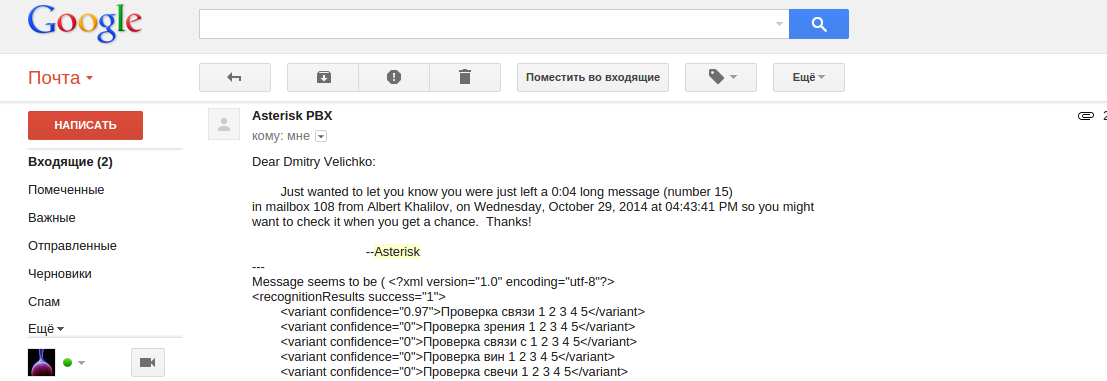Привет!
Решил поделиться опытом интеграции Asterisk и сервиса Яндекса по распознаванию речи.
Загорелось моему заказчику внедрить в свою АТС фичу Voice2Text.
В качестве АТС использовался FreePBX.
Сразу в голову пришло использование сервисов распознавания речи от Google, но после нескольких часов безуспешных попыток добиться нужного результата решил попробовоть аналогичный сервис Яндекса.
Подробности под катом.
Исходные данные:
FreePBX Distro 12 Stable-6.12.65, CentOS 6.5, Asterisk 11 + неимоверное желание реализовать фичу Voice2Text :)
По умолчанию FreePBX пишет все записи в .wav, нам же нужно передать файлы на распознавание в .mp3. Для это воспользуемся sendmailmp3.
Работу sendmailmp3 можно разбить на некоторые этапы:
- «поймать» поток
- проанализировать содержание электронной почты
- разделить сообщение на части
- извлечь аудиофайл
- конвертировать wav в mp3
- восстановить содержимое почты
- Передать сообщение команде sendmail
Воспользуемся скриптом, который установит sendmailmp3 и все необходимые для работы пакеты.
Переходим в /tmp:
cd /tmp
Cкачиваем скрипт, который установит sendmailmp3:
wget http://pbxinaflash.com/installmp3stt.sh
Делаем файл исполняемым:
chmod +x installmp3stt.sh
И запускаем скрипт:
./installmp3stt.sh
Далее идем в веб-интерфейс FreePBX, Вкладка Settings, Voicemail Admin, Settings:
И там в поле mailcmd пишем /usr/sbin/sendmailmp3
А в поле format: wav

Теперь наши сообщения будут пересылаться на почту в формате mp3, добавим фичу Voice2Text.
Выбор сервисов Яндекса обусловлен тем, что можно отсылать файл прямо в mp3, а не перекодировать во flac или speex (по крайней мере другой информации о поддерживаемых форматах я не нашел), а также тем, что максимальная длина сообщения значительно больше нежели у гугла.
Прежде чем наш скрипт начнет полноценно работать, необходимо пройти по ссылке, далее зайти в кабинет разработчика, авторизироваться в нем с помощью почтового ящика яндекса и запросить API-ключ. После этого вам придет письмо на указанную почту с дальнейшими инструкциями:

После того, как ваш ключ активирован, необходимо сформировать curl-запрос, который будет отсылать наш файлик на распознавание. Вид должен быть следующий:
asr.yandex.net/asr_xml?
uuid=<уникальный идентификатор пользователя>
& key=<API-ключ>
& topic=<тема голосового запроса>
& [lang=<язык запроса>]
Поддерживаются следующие форматы:
- audio/x-speex 1
- audio/x-pcm;bit=16;rate=8000
- audio/x-pcm;bit=16;rate=16000 2
- audio/x-alaw;bit=13;rate=8000
- audio/x-wav
- audio/x-mpeg-3 3
Ответ возвращается в виде XML, содержащего n-best список гипотез распознавания (до 5 значений) с указанием степени достоверности для каждой гипотезы.
Пример удачного распознавания:
<?xml version=«1.0» encoding=«utf-8»?>
улица басманная
Пример неудачного распознавания:
<?xml version=«1.0» encoding=«utf-8»?>
/>
В результате чего на указанный вами почтовый ящик падает сообщение с вариантами распознавания и аттачем с mp3-файлом подобное этому:

Получившийся в результате скрипт имеет следующий вид:
#! /bin/sh
# Asterisk voicemail attachment conversion script, including voice recognition using Google API
#
# Revision history :
# 22/11/2010 - V1.0 - Creation by N. Bernaerts
# 07/02/2012 - V1.1 - Add handling of mails without attachment (thanks to Paul Thompson)
# 01/05/2012 - V1.2 - Use mktemp, pushd & popd
# 08/05/2012 - V1.3 - Change mp3 compression to CBR to solve some smartphone compatibility (thanks to Luca Mancino)
# 01/08/2012 - V1.4 - Add PATH definition to avoid any problem (thanks to Christopher Wolff)
# 31/01/2013 - V2.0 - Add Google Voice Recognition feature (thanks to Daniel Dainty idea and sponsoring :-)
# 04/02/2013 - V2.1 - Handle error in case of voicemail too long to be converted
# set language for voice recognition (en-US, en-GB, fr-FR, ...)
LANGUAGE="ru_RU"
# set PATH
PATH="/usr/local/sbin:/usr/local/bin:/usr/sbin:/usr/bin:/sbin:/bin"
# save the current directory
pushd .
# create a temporary directory and cd to it
TMPDIR=$(mktemp -d)
cd $TMPDIR
# dump the stream to a temporary file
cat >> stream.org
# get the boundary
BOUNDARY=`grep "boundary=" stream.org | cut -d'"' -f 2`
# cut the file into parts
# stream.part - header before the boundary
# stream.part1 - header after the bounday
# stream.part2 - body of the message
# stream.part3 - attachment in base64 (WAV file)
# stream.part4 - footer of the message
awk '/'$BOUNDARY'/{i++}{print > "stream.part"i}' stream.org
# if mail is having no audio attachment (plain text)
PLAINTEXT=`cat stream.part1 | grep 'plain'`
if [ "$PLAINTEXT" != "" ]
then
# prepare to send the original stream
cat stream.org > stream.new
# else, if mail is having audio attachment
else
# cut the attachment into parts
# stream.part3.head - header of attachment
# stream.part3.wav.base64 - wav file of attachment (encoded base64)
sed '7,$d' stream.part3 > stream.part3.wav.head
sed '1,6d' stream.part3 > stream.part3.wav.base64
# convert the base64 file to a wav file
dos2unix -o stream.part3.wav.base64
base64 -di stream.part3.wav.base64 > stream.part3.wav
# convert wav file to mp3 file
# -b 24 is using CBR, giving better compatibility on smartphones (you can use -b 32 to increase quality)
# -V 2 is using VBR, a good compromise between quality and size for voice audio files
lame -m m -b 24 stream.part3.wav stream.part3.mp3
# convert back mp3 to base64 file
base64 stream.part3.mp3 > stream.part3.mp3.base64
# generate the new mp3 attachment header
# change Type: audio/x-wav to Type: audio/mpeg
# change name="msg----.wav" to name="msg----.mp3"
sed 's/x-wav/mpeg/g' stream.part3.wav.head | sed 's/.wav/.mp3/g' > stream.part3.mp3.head
# convert wav file to flac compatible for Google speech recognition
# sox stream.part3.wav -r 16000 -b 16 -c 1 audio.flac vad reverse vad reverse lowpass -2 2500
# call Google Voice Recognition sending flac file as POST
curl -v -4 "asr.yandex.net/asr_xml?key=23988820-8719-4a2e-82ba-9ddd5a9bfe67&uuid=12345678123456781234567812345678&topic=queries&lang=ru-RU" -H "Content-Type: audio/x-mpeg-3" --data-binary "@stream.part3.mp3" 1>audio.txt
# curl --data-binary @audio.flac --header 'Content-type: audio/x-flac; rate=16000' 'https://www.google.com/speech-api/v2/recognize?key=AIzaSyB5lwncPRYpNrHXtN-Sy-LNDMLLU5vM1n8&xjerr=1&client=chromium&pfilter=0&lang='ru_RU'&maxresults=1' 1>audio.txt
# extract the transcript and confidence results
FILETOOBIG=`cat audio.txt | grep "<HTML>"`
TRANSCRIPT=`cat audio.txt | cut -d"," -f3 | sed 's/^.*utterance":"(.*)"$/1/g'`
CONFIDENCE=`cat audio.txt | cut -d"," -f4 | sed 's/^.*confidence":0.([0-9][0-9]).*$/1/g'`
# generate first part of mail body, converting it to LF only
mv stream.part stream.new
cat stream.part1 >> stream.new
sed '$d' < stream.part2 >> stream.new
# beginning of transcription section
echo "---" >> stream.new
# if audio attachment is too big
if [ "$FILETOOBIG" != "" ]
then
# error message
echo "Voice message is too long to be transcripted." >> stream.new
else
# append result of transcription
echo "Message seems to be ( $CONFIDENCE% confidence ) :" >> stream.new
echo "$TRANSCRIPT" >> stream.new
fi
# end of message body
tail -1 stream.part2 >> stream.new
# append mp3 header
cat stream.part3.mp3.head >> stream.new
dos2unix -o stream.new
# append base64 mp3 to mail body, keeping CRLF
unix2dos -o stream.part3.mp3.base64
cat stream.part3.mp3.base64 >> stream.new
# append end of mail body, converting it to LF only
echo "" >> stream.tmp
echo "" >> stream.tmp
cat stream.part4 >> stream.tmp
dos2unix -o stream.tmp
cat stream.tmp >> stream.new
fi
# send the mail thru sendmail
cat stream.new | sendmail -t
# go back to original directory
popd
# remove all temporary files and temporary directory
sleep 50
rm -Rf $TMPDIR
На мой взгляд этот вариант несколько проще, нежели было описано тут, т.к. все сводится к запуску и изменению одного скрипта и пары кликов в веб-интерфейсе, а также присылает записи в mp3, а не в .wav. Безусловно, кто-то скажет, что это не unix-way:), но может кому-то будет полезно, хотя бы в целях ознакомления.
Автор: j3st3r






